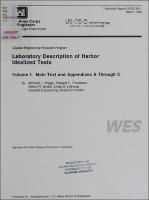Please use this identifier to cite or link to this item:
https://hdl.handle.net/11681/12628| Title: | Laboratory description of harbor idealized tests, Volume 1 |
| Authors: | Briggs, Michael Jeffrey Thompson, Edward F. Green, Debra R. Lillycrop, Linda S. |
| Keywords: | Data sets Harbors Ports Harbor modeling Harbor numerical models Harbor wave transformation Irregular waves Physical models Hydrodynamics Shoaling Hydraulic models |
| Publisher: | Coastal Engineering Research Center (U.S.) Engineer Research and Development Center (U.S.) |
| Series/Report no.: | Technical report (U.S. Army Engineer Waterways Experiment Station) ; CERC-93-1. |
| Description: | Technical Report Abstract: A three-dimensional, physical model study of a generalized harbor and entrance using regular and irregular waves and tidal ebb currents was conducted in the directional spectral wave basin. The purpose of this study was to (a) gain a better understanding of the physics involved in wave transformation from deep water into harbors, (b) confirm accurate simulation of this transformation in physical models, (c) verify the HARBD numerical model, a steady-state hybrid element model which includes the effects of bottom friction and boundary absorption in harbors of arbitrary configuration and variable bathymetry, and (d) generate a data set for improving Corps design procedures. The three-dimensional, 1:45 scale physical model reproduced a rectangular, 40-ft-deep flat-bottom harbor, contoured 40-ft entrance channel, and nearshore bathymetry. Bathymetry of the entrance channel and offshore area were representative of field conditions. The physical model of the idealized harbor included regular and irregular waves and ebb currents to study the effects that frequency and directional spreading, harbor resonance, wave grouping, channel entrance, and wave-current interaction have on harbor response. Typical prototype wave periods were 8 and 14 sec (1.19 and 2.09 sec, respectively, in the model). A prototype wave height of 3.75 ft (1 in. model) was selected for all tests to prevent overtopping and breaking and minimize nonlinear interactions. Waves had overall mean wave directions of 0 deg and ±22.5 deg, relative to a direction perpendicular to the wavemaker. Tidal ebb currents of 0.5 knot (0.88 fps prototype, 0.13 fps model) were created to study the wave-current interaction in the nearshore region outside the entrance channel. Boundary conditions in the harbor and channel included fully reflecting vertical walls and low-reflecting 1:1.3 revetted stone slopes. A total of 374 runs were completed using 20 capacitance wave gages and 4 electromagnetic current meters in 9 different gage configurations. Gage locations were selected near the basin boundaries (i.e. comers), the areas where the largest harbor response is typically observed. This report describes the laboratory data collection effort and documents model set-up, wave conditions, the test program, and the testing procedure. |
| Rights: | Approved for public release; distribution is unlimited. |
| URI: | http://hdl.handle.net/11681/12628 |
| Appears in Collections: | Technical Report |
Files in This Item:
| File | Description | Size | Format | |
|---|---|---|---|---|
| TR-CERC-93-1-V1.pdf | 14.82 MB | Adobe PDF |  View/Open |